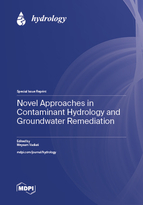Novel Approaches in Contaminant Hydrology and Groundwater Remediation
A special issue of Hydrology (ISSN 2306-5338). This special issue belongs to the section "Surface Waters and Groundwaters".
Deadline for manuscript submissions: closed (28 February 2025) | Viewed by 42351
Special Issue Editor
Interests: hydrogeology; machine learning; artificial intelligence; groundwater; clustering
Special Issues, Collections and Topics in MDPI journals
Special Issue Information
Dear Colleagues,
Quality of surface and groundwater are of the most important elements of water systems around the world. Over-exploration, urbanization, climate change, and anthropogenic activities are linked to water degradation and lead to extreme threats for wildlife at a local or global scale. Various remediation techniques have recently been introduced in the literature, representing a significant research trend. Recently novel approaches such as machine learning, remote sensing, and optimization methods have been used extensively by different researchers to monitor, control, maintain, and remediate contaminant. Additionally, there has been a specific trend in contaminant-based research topics to meet the Sustainable Development Goals. Although there is a clear increase in the number of studies in this area of study, topics such as PFAS, contaminant management, and medical contaminants have been overlooked or received less attention. Thus, this Special Issue has been designed to focus on the different aspects of contaminant hydrology and groundwater remediation with an emphasis on novel methods.
More specifically, the main purpose of this Special Issue is to introduce, apply, and compare different novel and cutting-edge science in the area of surface and groundwater contamination.
For this Special Issue, we invite the submission of research articles related to water contamination, including but not limited to:
- Study of contaminant mitigation;
- Petroleum contamination and PFAS;
- Risk, hazard, and vulnerability assessment;
- Management and modeling of water contamination;
- Environmental planning toward water remediation;
- Economic and social models and impact assessment;
- Implications of water contamination on ecology and wildlife;
- Implications of water contamination on agriculture and food supply;
- Surface and groundwater contamination and Sustainable Development Goals;
- Development of monitoring tools for observing and monitoring contamination.
Dr. Meysam Vadiati
Guest Editor
Manuscript Submission Information
Manuscripts should be submitted online at www.mdpi.com by registering and logging in to this website. Once you are registered, click here to go to the submission form. Manuscripts can be submitted until the deadline. All submissions that pass pre-check are peer-reviewed. Accepted papers will be published continuously in the journal (as soon as accepted) and will be listed together on the special issue website. Research articles, review articles as well as short communications are invited. For planned papers, a title and short abstract (about 100 words) can be sent to the Editorial Office for announcement on this website.
Submitted manuscripts should not have been published previously, nor be under consideration for publication elsewhere (except conference proceedings papers). All manuscripts are thoroughly refereed through a single-blind peer-review process. A guide for authors and other relevant information for submission of manuscripts is available on the Instructions for Authors page. Hydrology is an international peer-reviewed open access monthly journal published by MDPI.
Please visit the Instructions for Authors page before submitting a manuscript. The Article Processing Charge (APC) for publication in this open access journal is 1800 CHF (Swiss Francs). Submitted papers should be well formatted and use good English. Authors may use MDPI's English editing service prior to publication or during author revisions.
Keywords
- modeling and monitoring
- climate change
- contaminant management
- natural degradation
- impacts
- natural hazards
- sustainable development goal
- wildfire effect of water quality
- PFAS
Benefits of Publishing in a Special Issue
- Ease of navigation: Grouping papers by topic helps scholars navigate broad scope journals more efficiently.
- Greater discoverability: Special Issues support the reach and impact of scientific research. Articles in Special Issues are more discoverable and cited more frequently.
- Expansion of research network: Special Issues facilitate connections among authors, fostering scientific collaborations.
- External promotion: Articles in Special Issues are often promoted through the journal's social media, increasing their visibility.
- Reprint: MDPI Books provides the opportunity to republish successful Special Issues in book format, both online and in print.
Further information on MDPI's Special Issue policies can be found here.






